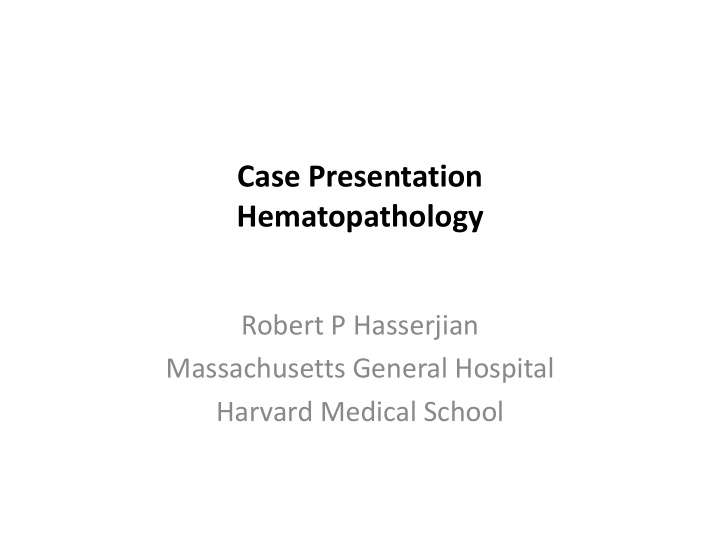



Case Presentation Hematopathology Robert P Hasserjian Massachusetts General Hospital Harvard Medical School
Clinical history • 24 year‐old man presented with unintentional weight loss (10‐15 lb) and was found to splenomegaly and marked leukocytosis • WBC 456.2 x 10 9 /L • HGB 7.5 g/dL • PLT 564 x 10 9 /L
Peripheral blood smear 31% polys, 5% bands, 1% lymphs, 1% monos, 4% eos, 4% basos, 16% metas, 30% myelos, 2% promyelos, 6% blasts
Bone marrow biopsy Bone marrow aspirate: myeloid‐predominant and left‐shifted with 5% blasts
Results of ancillary studies • Flow cytometry of bone marrow aspirate – 1% myeloid blasts • Cytogenetics – 46, XY, t(9;22)(q34;q11.2)[20] • BCR‐ABL1 RT‐PCR – BCR‐ABL1 rearrangement (B2/A2, p210 BCR‐ABL1 fusion protein) • NGS panel (SnapShot, 54 myeloid‐associated genes) – No reportable variants Diagnosis: Chronic myeloid leukemia, BCR‐ABL1+, in chronic phase
The Philadelphia chromosome and BCR‐ABL1 rearrangement Most quantitative RT‐PCR tests can only detect p210 BCR‐ABL1 transcript BCR‐ABL fusion proteins <1% p190 99% p210 <1% p230
Clinical course‐1 HU started • Treated initially with Imatinib hydroxyurea, then switched to started imatinib • After 3 weeks he developed a syncopal episode – WBC 2.9 x 10 9 /L, HGB 6.7 g/dL, PLT 24 x 10 9 /L • Imatinib was stopped due to the pancytopenia and he was discharged home
Clinical course‐2 • 10 days after stopping 2 nd bone imatinib, a CBC showed WBC marrow biopsy of 13.2 x 10 9 /L with “other cells” suspicious for blasts Imatinib restarted • Imatinib was restarted and a bone marrow biopsy was Imatinib performed 3 days later held • WBC at time of biopsy was 49.6 x 10 9 /L with 8% blasts
Bone marrow biopsy
Bone marrow aspirate 68% myeloids 13% erythroids 6% lymphocytes 4% eosinophils 1% basophils 4% promyelocytes 5% blasts
Flow cytometry 9% myeloid blasts CD33+ CD13+CD117+/‐CD34+ HLADR+ 4% B‐lymphoblasts CD19+CD20‐CD10+TdT+CD34+/‐CD38dim
CD34 CD117 MPO TdT
What is your diagnosis? • CML in chronic phase • CML in accelerated phase • CML in lymphoid blast crisis • CML in myeloid blast crisis • Unsure; await cytogenetics
CML‐AP criteria 13% 4% marrow, 8% blood
Results of ancillary studies • Karyotype 46,XY,t(9;22)(q34;q11.2)[16]/46,idem,inv(16)(p13.1q22)[4]
Now what is your diagnosis? • CML in chronic phase • CML in accelerated phase • CML in lymphoid blast crisis • CML in myeloid blast crisis • Unsure; await cytogenetics
CML‐BP • ≥20% blasts (myeloid or lymphoid) in blood or marrow criteria: • Extramedullary blast proliferation • Certain cytogenetic abnormalities define AML However: irrespective of the blast percentage inv(16) or t(16;16) t(15;17) t(8;21) PML‐RARA CBFB‐MYH11 RUNX1‐RUNX1T1
Results of ancillary studies • Karyotype 46,XY,t(9;22)(q34;q11.2)[16]/46,idem,inv(16)(p13.1q22)[4] • FISH: nuc ish(CBFBx2)(5'CBFB sep 3'CBFBx1)[12/100] • NGS assay for fusion of myeloid‐associated genes – BCR‐ABL1 fusion – CBFB‐MYH11 fusion • ABL1 mutation assay: No TKI‐resistance mutations
2 nd bone 100 WBC Clinical Course‐4 marrow biopsy Imatinib Dasatinib started restarted • Diagnosed with CML in 50 myeloid blast crisis Imatinib • Patient was switched from held imatinib to dasatinib – WBC rapidly declined to normal levels Peripheral blood blasts – Circulating blasts disappeared • Allogeneic bone marrow transplant planning was initiated
Clinical Course‐5 • 10 weeks later, the patient presented with low back and knee pain and was noted to have recurrent splenomegaly • CBC results – WBC 13.7 x 10 9 /L • 58% polys, 32% lymphs, 3% monos, 2% eos, 3% basos, 1% metas, 2% myelos – HGB 15.1 g/dL – PLT 85 x 10 9 /L • Another bone marrow biopsy was performed. . .
Peripheral smear Rare blasts seen on scanning
Bone marrow biopsy Bone marrow aspirate Bone marrow aspirate: 56% blasts
Flow cytometry
Results of ancillary studies • Karyotype: 46,XY,t(9;22)(q34;q11.2)[15]/46,idem,del(9)(p13p22)[16]/46,XY[1] • NGS assay for fusion of myeloid‐associated genes – BCR‐ABL1 fusion – CBFB‐MYH11 fusion (very low level) • ABL1 mutation assay: ABL1 kinase domain T315I mutation Diagnosis: Chronic myeloid leukemia, BCR‐ABL1+, in B‐lymphoid blast crisis
Tyrosine kinase inhibitors • Imatinib • Dasatinib • Nilotinib • Bosutinib • Ponatinib
Clinical followup • Patient was treated with HAM ALL induction regimen and ponatinib • Achieved remission 1 month later, with no evidence of leukemia in post‐therapy bone marrow – BCR‐ABL1 quantitative RT‐PCR: 0.0095% • Underwent allogeneic stem cell transplant • 3 months after SCT, bone marrow showed 2% B‐lymphoblasts and RT‐PCR showed BCR‐ABL1 transcript (13.9%), consistent with relapsed disease
Diagnosis: Chronic myeloid leukemia, BCR‐ABL1+ , in myeloid blast crisis followed by lymphoid blast crisis Take home points: Beware of lymphoblasts in CML! AML‐associated translocations can rarely occur in the setting of CML blast crisis and in this context do not convey a favorable prognosis
Recommend
More recommend